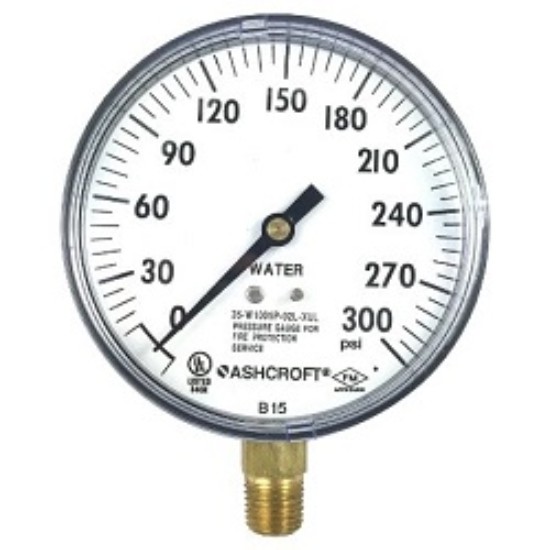
The importance of pressure gauges on a fire sprinkler system can sometimes be overlooked. It is a common misconception that if a pressure gauge is registering pressure then it is operating properly. We must first take a look at what these gauges are and how they are used in order to completely understand their importance as a part of your sprinkler system.
Types of Pressure Gauges: Dry and Liquid Filled
Pressure gauges for a fire sprinkler system come in two basic types: dry and liquid filled. The dry gauge is most common; it consists of a numbered dial with an indicating needle that is attached to a spring loaded mechanism. This spring is compressed by pressure from the system, causing the needle to rise in relation to the amount of pressure. Liquid filled gauges operate under the same principle but are completely filled with liquid, usually glycerin. The liquid does a couple things, it lubricates and protects components in the gauge from wear and corrosion, while at the same time it dampens vibration and small spikes or jumps of the needle as pressures change. This creates a more sensitive precise gauge. For that reason, these gauges, which are higher in price, are usually used on testing or other more demanding applications.
Selecting the Correct Gauge
Gauges can be manufactured for a specific application, such as fire pump readings and high pressure systems, or for a specific pressure type such as water pressure, air pressure, or a combination. Choosing the proper gauge for the application should be done by a trained Life Safety professional, as not just any gauge may be installed. NFPA 13 requires the gauge be approved for the application as well as have UL and FM approval. Your Life Safety Partner will also have the expertise needed to determine gauge location and correct installation procedures. Gauges are typically installed on ¼”, 3-way valves to allow easy replacement without taking the system out of service since fire sprinkler systems should always be functioning.
Gauge use in a Fire Sprinkler System
Fire sprinkler systems are always on, active, and supplied by an automatic water supply. Gauges help us ensure that the system is active, in service, and proper water supply and pressure is available. Located at various points in the system, they give us an indication of what the system status is and if anything has changed that may affect performance. Water pressure gauges at the control risers indicate the system is active and supplied by water pressure. This “resting active” pressure is known as static pressure. When the main drain on the system is opened completely, a water flowing pressure reading can be taken here which is known as a residual pressure. Your Life Safety Partner will track these readings during annual inspections, a change in this residual pressure can give warning to changes in the water supply or supply piping system. Gauges monitoring air pressure on dry systems are important for setting the correct air to water pressures on dry valves and recording trip pressures. A system air pressure that is too high could result in delayed trip times, too little could cause false trips. Gauges are used too monitor pressures on standpipes, fire pump performance, and many other functions.
Inspection and Maintenance
As with any other critical component of a sprinkler system, gauges must be tested, inspected and maintained. Gauges are used in almost every stage of system testing. Quarterly, semi-annual and annual inspections all include testing that involves gauges. NFPA requires a monthly visual inspection of gauges noting any damage, leakage, or unusual readings. The date of the gauge should also be noted in inspections, as NFPA requires all gauges to be tested or replaced every 5 years. When gauges are tested, they must fall within a +/- 3% accuracy range or they have to be re-calibrated. Because the cost of new gauges is relatively low, it is common to have the gauges replaced rather than paying for the testing and re-calibrating.
A1 is a leading expert on the latest technology in life safety. To find out more information or to ask a question, click here or call us at 1-800-859-6198.
